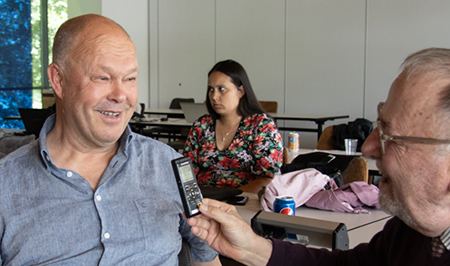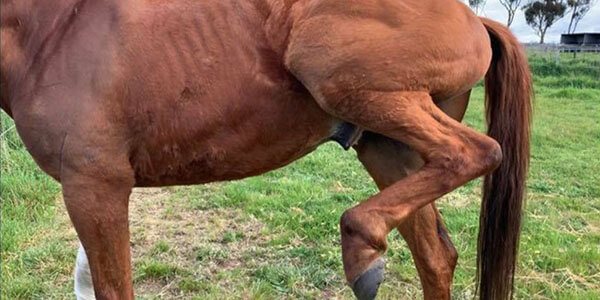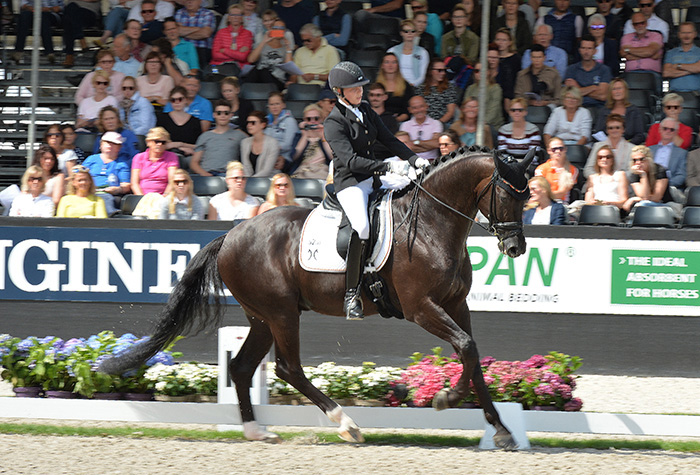There is a disease that right now poses a far greater threat to the future of sporthorse breeding than WFFS ever did, a disease that is spread through some of the most famous, and most used, Warmblood breeding lines.
You might not have got this impression from the bland statement issued by the FEI, but talk to the breeders, the ones who are really connected with horses, and you get a very different picture.

Eugène Reesink, one of the most astute observers of the sporthorse scene, suggests that the condition known as shivers is a far greater problem than WFFS.
On my way to Aachen 2023, I led a small group of breeding enthusiasts on a tour of some of the Netherlands and Germany’s top breeding establishments. We were lucky to visit Reesink Horses, going to their stallion station, and sales barn.
I also hosted a very fine dinner, and our guests were Eugène and his wife Annebeth and son Bas. The food was great and the wine flowed, and somehow the conversation settled on one of the hidden problems of Warmblood Breeding, the condition known as Shivers. The next day we were visiting Eugène, and this time I had my recorder in my hand…
I think it was your son, Bas who started the conversation about shivers, and I was lucky I had sitting next to me, successful sporthorse breeder, New Zealander, Judith Matthews, and she had the problem with an imported mare, and eventually the only solution was to have the mare put down. It’s a huge problem, it’s a real problem, do you think it is a problem that has got worse recently Eugène, or has it always been with us?
“I think it is a huge problem because if you have it, there is nothing you can do to fix it. How many horses have it? I have no idea, and that is one of the biggest problems, the studbooks are not paying enough attention to it, in my opinion. And I think the problem became bigger within the last 20 years.”
“I’m sure if you ask studbooks, which lines bring cribbing, or which bloodlines bring good movers, or bad jumpers, good jumpers, they know everything but shivering, nobody knows. And I think the problem is that it is a hidden problem, the studbooks don’t pay enough attention to it. When they have a stallion that is showing it, then that stallion is out but I have seen stallions, two or two-and-a-half-years-old, at stallion shows, 100% shivering and they are approved! They shouldn’t be, but that is the way it is. The studbooks should be sharp on it. But on the other hand: you don’t always notice it during a presentation. So yes, it is a problem.”
Bas was saying that, you guys know stallions that are producing shiverers and you can avoid their progeny, but the scary thing is that your son said he thought it was associated with popular and commonly used stallions, so we are talking about a huge genetic pool in the breeding population…
“Now you want me to say names of stallions, but I’m not going to do that. But there are certain popular stallions that you see offspring from, which every now and then, are shivering. That’s absolutely true. And we are careful buying offspring of those stallions because of this, totally careful.”
 I asked Bas, what is the solution? Because we can’t make a test like WFFS and find out which stallions are positive. He said this was up to the individual stud owners to be responsible…
I asked Bas, what is the solution? Because we can’t make a test like WFFS and find out which stallions are positive. He said this was up to the individual stud owners to be responsible…
“Yes, that’s how it is at the moment, but that’s my biggest problem, I think the studbooks should be responsible and recognize the problem. The stallion owner is the first one to recognize it for sure. But I think in the end, the studbook is responsible for bloodlines, and breeding, and they have to find a way, but at the moment I don’t see any studbook that is really concentrating on this problem.”
“If you know for sure that certain stallions are giving it, you can’t sit still as a studbook and say I can’t prove it. That’s too easy. You have to find a way to collect data.”
I know that today it’s very different from over dinner, where the wine flowed, so you are not going to say which stallions are bad, but can you say which ones are good?
“The stallions we mentioned yesterday that’s off the record. It’s hard to say that stallion is bad because of this. Some of these ‘shivering’ stallions have also made an enormous positive contribution to the development of today’s dressage horse.”
“And it is also a complex problem. Also for the studbooks. It’s not just shivering. Almost all neurological abnormalities are more or less related. Also think of ataxia, wind puff, slab (hemiplegia larynges), etc. And then there is the fact that not all neurological conditions are hereditary, but can also be caused by external circumstances. And neurological problems can sometimes not reveal themselves until the age of three or four.”
“Of course, all this does not make collecting data easy. But not easy doesn’t mean you should look away. I think it is the task of the studbooks to collect this data. They should listen to breeders, trainers, riders, veterinarians, farriers, etc. These practitioners can give you so much information. I think you will be amazed at the useful information you collect in this way.”
The popular stallion Don Juan de Hus stayed at my friends’ stable for a week and they saw that he had shivering and they told me about it. And the problems Don Juan’s world champion son, Don Martillo have been well popularized with one of his owners saying the stallion has shivers… I have also been told that the problem exists in both the Jazz and Weltmeyer lines, which is a huge problem given their influence..
“This is exactly what I mean by collecting data. Studbooks need to know this and record it. And then it has to be looked at how such a stallion inherits it. And the same goes for the parents of such a stallion, whether they inherit this more often. Only in this way can you try to tackle these problems at the moment. And if you have enough data to (cautiously) draw conclusions, make it public.
“But if you start to hide things, or close your eyes for problems by not investigating the cause and sources of problems, that doesn’t make sense, breeding doesn’t progress.”

Don Martillo – World Champion Young Horse, by Don Juan de Hus by Jazz. One of his owners says the stallion has shivers…
Of course, if you want to pretend that everything is under control and there is no great problem, you can read the FEI statement:
WBFSH State of the Industry Report 2023

So then, how does the average equestrian know which popular stallions are possible carriers or not? My 17.1hh 19yo gelding has shivers, but it is manageable and he is still in good work. That said, I’d rather not have to deal with this in my next horse, but is it avoidable? We are taking incremental steps (very small steps, but steps indeed) in understanding the genetic mRNA basis of shivers see recent article earlier this year (https://www.ncbi.nlm.nih.gov/pmc/articles/PMC10365050/#jvim16784-bib-0002); but until we have affordable markers and at least probabilities of genetic inheritance versus size/environment, how are we to know if/when a prospect is vulnerable without transparency? While it may or may not be career ending/limiting, full disclosure is needed and without it, we are still in an uninformed guessing game as to who are the a popular stallions? All of them? Some of them?